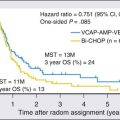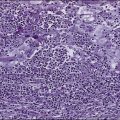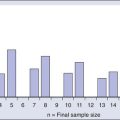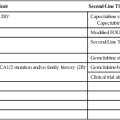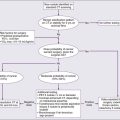WHO Classification of Hematologic Malignancies
Elaine S. Jaffe and James Vardiman
• The World Health Organization (WHO) classification of hematologic neoplasms includes tumors of lymphoid, myeloid, histiocytic, and dendritic cell lineages.
• Each disease is defined as a distinct entity based on a constellation of morphologic, clinical, and biological features.
• The cell of origin is the starting point of disease definition.
• Some lymphomas and leukemias can be identified by routine morphologic approaches. However, for many diseases, knowledge of the immunophenotype and molecular genetics/cytogenetics plays an important role in the differential diagnosis.
• The sites of presentation and involvement are an important clue to underlying biological distinctions. Extranodal lymphomas differ in many respects from their nodal counterparts.
• Many lymphoma entities display a range in cytologic grade and clinical aggressiveness, making it difficult to stratify lymphomas according to clinical behavior. A number of prognostic factors influence clinical outcome, including stage, international prognostic index, cytologic grade, gene expression profile, secondary genetic events, and the host environment.
• The WHO classification includes five major categories of myeloid diseases, all of which are clonal stem cell disorders exhibiting variable maturation in the affected lineages and either effective or ineffective hematopoiesis:
 Myeloid (and lymphoid) neoplasms with eosinophilia and abnormalities of PDGFRA, PDGFRB, or FGFR1
Myeloid (and lymphoid) neoplasms with eosinophilia and abnormalities of PDGFRA, PDGFRB, or FGFR1
 Myelodysplastic/myeloproliferative neoplasms
Myelodysplastic/myeloproliferative neoplasms
• Among myeloid neoplasms, genetic features predict behavior better than morphology alone, necessitating genetic studies for accurate diagnosis.
Introduction
In recent years, the discipline of hematopathology has emphasized the integration of morphology and biological markers for diagnosis. In this respect, the approaches used in hematologic diagnosis often have served as a model for other areas of pathology. For example, in the early 1980s, detection of rearrangements of the antigen receptor genes in lymphoid cells was used to indicate both clonality and cell lineage, long before molecular diagnostic techniques became commonplace in pathology. Biological approaches such as immunohistochemistry, cytogenetics, and molecular biology enhance diagnostic accuracy and play a critical role in the definition of disease entities.1
Historical Background
The earliest classification schemes for lymphomas—those proposed by Gall and Mallory2 and Rappaport3—were based on cytologic and architectural features. However, insights into the complexities of the normal immune system led to attempts to relate the lymphomas to their normal cellular counterparts. In the 1970s, efforts to establish an immunologically based classification were led largely by Karl Lennert and colleagues in Europe and by Lukes and Collins in the United States.1 Several European and American groups published proposals for the classification of lymphoma, and competing classification systems in use in clinical studies made it difficult to compare outcome data from different treatment centers.4–7 The inability of the pathologists to develop consensus and agree on a common approach led to the development of a working formulation for the non-Hodgkin lymphomas, after a National Cancer Institute–directed study was conducted to evaluate the six published schemes.8
The working formulation tried to stratify lymphomas according to clinical outcome based on clinical trials conducted in the 1970s.8 Its proponents believed that attempts to relate tumors to the normal immune system were premature, and in essence it was a morphologically based scheme, differing in only minor ways from the Rappaport classification, which had been in widespread use in the United States. A similar paradigm developed in the classification of acute myeloid and lymphoid leukemias. Earlier classification systems emphasized morphologic approaches, although the French–American–British (FAB) classification did use enzyme cytochemistry to identify cellular lineage and degree of maturation, at least within the myeloid and monocytic neoplasms.9 The categories of acute lymphoblastic leukemia—L1, L2, and L3—included both mature and immature lymphoid malignancies, because L3 was largely composed of mature blastic B cells similar to the cells of Burkitt lymphoma (BL). Although L1 and L2 were both of lymphoblastic origin, they correlated poorly with precursor T- or B-cell lineage.
Modern immunophenotypic and molecular approaches for characterizing lymphoid and myeloid cells are now readily available. The use of these new biological approaches has transformed our understanding of hematologic neoplasia. Immunophenotypic, cytogenetic, and genotypic studies have permitted an impartial analysis of questions that were unresolved when addressed with only routinely stained sections or smears and have allowed the incorporation of objective criteria into the definition and diagnostic criteria for hematologic malignancies. Indeed, a broad international consensus has emerged on many topics. This consensus was embodied in the Revised European-American Classification of Lymphoid Neoplasms (REAL classification) published by the International Lymphoma Study Group in 199410 and was broadened to include myeloid and histiocytic neoplasms in the World Health Organization (WHO) classification.11
The Next Steps for Lymphoma: REAL to WHO
The REAL classification10 and its successor the WHO classification11 represented a new paradigm in the classification of lymphoid neoplasms. The focus was on the identification of “real” diseases, rather than a global theoretical framework, such as survival (working formulation), or cellular differentiation (Kiel classification). The REAL classification was based on the building of consensus and recognized that a comprehensive classification system was beyond the experience of any one individual. The WHO classification effort, which involved input from multiple experts, maintained this approach.
The REAL classification departed from traditional schemes by emphasizing that each disease was a distinct entity defined by a constellation of laboratory and clinical features—that is, morphology, immunophenotype, genetic features, clinical presentation, and course. The inclusion of clinical criteria was one of the more novel aspects of the International Lymphoma Study Group approach. The REAL classification recognized that the site of presentation is often a signpost for underlying biological distinctions, as in extranodal lymphomas of the mucosal-associated lymphoid tissues12 or many forms of T-cell lymphoma.13 Accurate diagnosis requires knowledge of the clinical history, because biologically distinct entities may appear cytologically similar.
Moreover, within a given disease entity, a number of prognostic factors influence the clinical outcome. Cytologic grade is one type of prognostic factor and is used in the stratification of follicular lymphoma. Clinical features, such as the stage or international prognostic index, also markedly affect survival and response to treatment.14,15 For these reasons, it is not possible to stratify lymphoma subtypes according to clinical grade. Moreover, clinical groupings for either protocol treatment or routine clinical practice are generally not feasible. In evaluating new therapies, the data for each disease must be evaluated individually. Indeed, treatment approaches for one type of lymphoid malignancy are not necessarily applicable to other diseases, even of the same cell lineage. This point is exemplified by hairy cell leukemia, a rare disease for which highly effective forms of therapy have been developed.16 However, the purine analogues 2′ deoxycoformycin and 2′-chlorodeoxyadenosine have not been similarly effective in treating other B-cell leukemias and lymphomas.
The REAL classification was the first to emphasize the importance of molecular oncology in defining disease entities. Cancer is increasingly recognized as a genetic disease.17 For many lymphomas, a good correlation exists between the molecular pathogenesis and routine histologic and immunophenotypic features. For example, the t(14;18) translocation involving the BCL2 and IGH@ genes is highly associated with follicular lymphoma diagnosed by routine methods. In addition, the recognition of some molecular phenotypes can be recognized by immunohistochemistry, such as cyclin D1 overexpression in the diagnosis of mantle cell lymphoma, or anaplastic lymphoma kinase (ALK) expression in anaplastic large cell lymphoma. Variations in the genetic complexity score also have been shown to influence clinical outcome, with pediatric lymphomas generally having many fewer genetic anomalies than adult lymphomas.18,19
Subsequent studies affirmed the principles of the REAL classification.20 The use of precise disease definitions enhanced diagnostic accuracy and reduced inter-observer variability. The significance of identifying individual disease entities was confirmed by overall survival and failure-free survival data.
Precise disease definitions have also facilitated the discovery of the molecular pathogenesis of lymphomas and leukemias. Many pathogenetic insights have followed on the heels of the identification of a disease along clinical lines (Table 16-1). Moreover, advances in therapy are best achieved when studies are conducted on a homogeneous disease entity. For example, the approaches to therapy of extranodal marginal B-cell lymphoma of mucosal-associated lymphoid tissues type differ from those of more systemic small B-cell malignancies. The ultimate goal in this model is molecularly targeted therapy, directed at the genomic alterations specific to the tumor.
Table 16-1
Representative Pathogenetic Insights Based on a Disease-Oriented Approach to Lymphoma Classification
| Disease | Pathogenesis |
| Adult T-cell leukemia/lymphoma | HTLV-I |
| Extranodal NK/T-cell lymphoma, nasal type | EBV, genetics |
| Anaplastic large cell lymphoma | ALK |
| Mantle cell lymphoma | CCND1 |
| Follicular lymphoma | BCL2 |
| MALT lymphoma | Helicobacter, MALT1 |
| Burkitt lymphoma | MYC |
| Primary effusion lymphoma | HHV-8/KSHV |
In 2001 the International Agency for Research on Cancer, under the auspices of the WHO, published a unified and internationally accepted classification scheme for all lymphoid, myeloid, histiocytic, and dendritic cell neoplasms.11 The WHO monograph was part of a series encompassing all human neoplasms, with the goal to integrate pathology diagnosis with genetics to arrive at biologically relevant classification systems. The WHO adopted the approach of the REAL classification for the lymphoid malignancies, because this approach had been validated, and in turn applied the same principles to tumors of other hematopoietic lineages, mainly myeloid and histiocytic tumors.
The 2008 WHO Classification for Lymphomas
The latest edition of the WHO classification, which was published in 2008 (Box 16-1), incorporates many new advances from studies in recent years.21,22 For example, molecular profiling studies are leading to better delineation of aggressive B-cell lymphomas.23,24 Gene expression profiling studies identified two broad categories of DLBCL, with one group resembling germinal center B cells and a second group resembling activated peripheral blood B cells (ABCs). These studies are providing insights into the molecular pathways that are primarily deregulated in these tumors. For example, the ABC type of DLBCL is associated with activation of the nuclear factor (NF) κB pathway and deregulation of B-cell signaling.25 The importance of the host response and the tumor microenvironment has also been shown to be important in predicting outcome.26,27 The microenvironment also has been shown to influence prognosis in follicular lymphoma, independent of cytologic grade.28,29 These data additionally confirm that neoplastic lymphoid cells are still responses to immunoregulatory factors.
Stratification according to genetic and genomic profiling may soon have an impact on clinical practice. For example, DLBCLs of the ABC type demonstrate activation of the B-cell receptor signaling pathways, and genes involved in this pathway are often targets of mutation. Other aberrations drive DLBCLs of the germinal center B-cell type. Notably, new drugs such as the BTK inhibitor PCI-32765 target the B-cell signaling pathway, and in preliminary trials they have shown promise in the ABC type of DLBCL and in other B-cell malignancies such as chronic lymphocytic leukemia.25,30
Additionally, tumors that were thought to be distinct, such as classic Hodgkin lymphoma and primary mediastinal large B-cell lymphoma, have been shown through molecular approaches to share common pathways of activation and/ or deregulation31,32 and to share many genetic aberrations in common.33 These genomic insights have also helped elucidate the nature of lymphomas that appear to bridge the gap between classic Hodgkin lymphoma and mediastinal lymphoma, the so-called “grey zone lymphomas,” which also are termed “B-cell lymphoma with features intermediate between DLBCL and classic Hodgkin lymphoma” in the WHO classification.34,35 Indeed, composite, sequential, and grey zone lymphomas are observed with some regularity.36
Another “intermediate” category introduced into the WHO system is “B-cell lymphoma with features intermediate between DLBCL and BL.”37,38 Historically it has been difficult for pathologists to distinguish some DLBCL with a very high growth fraction from BL with atypical cytology. In addition, some cases have a molecular gene expression profile of BL but carry additional cytogenetic abnormalities, most often involving BCL2 or BCL6. These double-hit and triple-hit lymphomas have a very aggressive clinical course.39 This borderline category was introduced to recognize and delineate these cases. Although it is likely that this group of cases will be defined at the genetic level, the impact of an isolated MYC translocation in DLBCL has not been resolved.
The 2008 WHO classification includes other new areas of emphasis. The 2001 classification recognized two clonal lymphoid proliferations of indeterminate malignant potential, lymphomatoid granulomatosis (a B-cell–derived Epstein-Barr virus–driven process), and lymphomatoid papulosis (a usually clonal but indolent T-cell lymphoproliferative disease). In the past few years we have gained a much greater awareness of the multistep nature of lymphomagenesis, and a number of clonal lymphoid proliferations have been identified that, while carrying early genetic changes of malignancy, have a very limited capacity for progression. These proliferations include monoclonal B-cell lymphocytosis, which carries many of the molecular alterations of chronic lymphocytic leukemia40; follicular lymphoma in situ,41 which carries the BCL2/IGH@ translocation; and mantle cell lymphoma in situ,42 which carries the CCND1/IGH@ translocation. Each of these clonal proliferations may be detected in the patient using sensitive immunophenotypic or molecular methods but may not progress to clinically significant disease requiring therapeutic intervention. The fact that these alterations represent only an incipient step in the pathway to malignancy is underscored by the fact that cells carrying the BCL2 and CCND1 translocations can be found in healthy individuals.43 The likelihood of identifying the translocation increases with age. When recognized in tissues, the cells of these in situ lesions occupy the microanatomic compartment of the relevant cell type. Thus we see follicular lymphoma in situ within otherwise reactive-appearing germinal centers, or the cells of mantle cell lymphoma in situ occupying the mantle cell cuff. Examples of incipient lesions derived from T cells include seroma-associated anaplastic large cell lymphoma associated with breast implants44 and certain very indolent cutaneous T-cell lymphoproliferative “lymphomas,” such as primary cutaneous CD4+ small/medium-sized T-cell lymphoproliferative disease.47–47
Another new aspect of the WHO classification is the recognition of certain lymphoproliferative lesions that are preferentially associated with certain age groups. These lesions include the pediatric types of follicular lymphoma and marginal zone lymphoma, which occur mainly in children but also occur sporadically in older patients.48,49 At the other end of the spectrum, Epstein-Barr virus–positive DLBCL of the “elderly” is mainly seen in older individuals and is thought to be a result of a failure in immune surveillance.50,51 Although these tumors are most common past the age of 60 years, as with the “pediatric type” of lymphoma, they also occur sporadically in younger patients. The age distribution of these lesions may provide clues to pathogenesis and also aid in diagnosis. For example, it has been shown that DLBCLs occurring in children carry many fewer genetic aberrations than do morphologically similar tumors in adults.18,19 This fact may in part explain the excellent prognosis associated with most pediatric lymphomas.
The Myeloid Neoplasms: From FAB to WHO
In the current WHO classification (Summary Box), the myeloid neoplasms are stratified into leukemias comprising precursor cells (blasts) with minimal if any maturation, acute myeloid leukemia (AML), and neoplasms with proliferation and maturation in one or more of the myeloid lineages that is effective (myeloproliferative neoplasms; MPNs), ineffective (myelodysplastic syndrome; MDS), or effective in some lineages but not in others (MDS/MPN). An additional category, myeloid and lymphoid neoplasms with eosinophilia and abnormalities of PDGFRA, PDGFRB, or FRGR1, identifies a unique group of stem cell neoplasms in which the genetic lesion leads to a constitutively activated receptor tyrosine kinase (TK) that drives the proliferation and in which the neoplastic cells may show differentiation toward lymphoid or myeloid lineages with prominent eosinophilia in the blood, marrow, and/or other tissues.54–54 Because the neoplasms with PDGFRA and PDGFRB rearrangements respond to imatinib therapy, this category illustrates an example for which the classification may define an entity and molecularly directed therapy as well.
The FAB proposals provided uniform classification criteria for AML and MDS based on a disciplined approach to their morphology,9,55 and remnants of the FAB persist even in the most recent WHO classification of AML and MDS. The introduction of the FAB schemes coincided with advances in cytogenetic techniques and inquiry into the genetic nature of leukemic cells, and a number of correlations were soon found between some FAB subgroups and specific cytogenetic abnormalities. Furthermore, it became apparent that recurring cytogenetic abnormalities often provide better prognostic information than morphologic classification alone.58–58 It was not surprising therefore that the Clinical Advisory Committee for the third edition of the WHO classification recommended incorporation of cytogenetic abnormalities of proven clinical significance into the classification of myeloid malignancies. Thus genetically defined subgroups of AML—mainly chromosomal translocations involving transcription factors associated with characteristic morphologic and clinical features—were introduced into the WHO classification.59
In the years between the third and fourth editions of the WHO classification, it was realized that multiple genetic lesions—not only microscopically detectable chromosomal abnormalities but also gene mutations—cooperate to establish the leukemic process.60 Importantly, some mutations, such as those involving NPM1 and CEBPA, were identified in cytogenetically normal AML (CN-AML), whereas others, such as mutated FLT3, were found not only in association with CN-AML but also with well-defined cytogenetic abnormalities.58,61–63 The detection of mutations in CN-AML opened a new avenue of inquiry into the pathogenesis and diverse outcomes of this large group of patients with AML. Additionally, some of the gene mutations, such as mutated NPM1 and CEBPA, are associated with consistent morphologic and phenotypic abnormalities and thus contribute to the recognition of specific new disease entities.
Currently, nearly 50% of all cases of AML are in part “genetically defined” in the WHO classification. More recent studies using full-genome evaluation techniques in AML have revealed an increasing number of mutations in genes encoding transcription factors, signaling proteins, and epigenetic regulators.66–66 How should these mutations be integrated into the WHO classification? Currently, all of the genetically defined AML entities have characteristic if not specific morphologic, phenotypic, and/or clinical features. Many of the recently reported mutations have an impact on prognosis but do not seem to define a distinct entity.67,68 For example, in CN-AML, mutated FLT3 confers a poor prognosis, yet it can be found in the core-binding factor AMLs and even in acute promyelocytic leukemia, as well as in cytogenetically normal patients.69 It is an important prognostic factor but does not define an entity. Recently, an international expert panel has proposed a scheme that integrates the WHO classification of genetically defined AML with genetic abnormalities that are mainly prognostic factors into a “standardized risk reporting scheme” that is useful for choosing therapy and that may serve as a model to integrate prognostic information with the classification.69
The 50% of cases of AML that do not fall into a “genetically defined” category illustrate how different features play a role in defining a disease entity. In the subgroups of AML with myelodysplastic-related changes, equal importance is given to morphology, clinical history, and cytogenetics in defining the entity, although admittedly, controversy exists about whether the myelodysplastic-related genetic abnormalities best define this group.70,71 In therapy-related AML, the history of exposure to cytotoxic therapy is the ultimate factor for inclusion. The subgroup “AML, not otherwise specified,” which lacks any distinct clinical, immunophenotypic, or genetic characteristics, remains defined largely by morphologic criteria similar to those in the initial FAB classification. This group will likely diminish as new knowledge accumulates.
The most recent WHO classification also emphasizes two AML-related but distinct categories, the unique myeloid proliferations related to Down syndrome and a recently recognized disorder, blastic plasmacytic dendritic cell neoplasm. This latter disorder includes most cases previously classified as blastic natural killer–cell lymphoma/leukemia or agranular CD4+ CD56+ hematodermic neoplasm and is an aggressive disorder derived from a precursor of plasmacytoid dendritic cells, cells that are part of the innate immune system.74–74 Although leukemic involvement is common, many cases manifest with cutaneous disease.
Another group of myeloid neoplasms that is partially genetically defined is the MPNs. The detection of the BCR-ABL1 fusion gene has been used for years to confirm the diagnosis of chronic myeloid leukemia. The more recent discovery of activating mutations of genes that encode TKs involved in signal transduction pathways has revolutionized the diagnostic assessment of the BCR-ABL1–negative MPNs. The principle mutation, JAK2 V617F, is found in almost all cases of polycythemia vera (PV) and in about 50% of cases of essential thrombocythemia (ET) and primary myelofibrosis (PMF). A few cases of PV carry a similar mutation of JAK2 exon 12, and up to 10% of patients with ET and PMF have mutations of MPL.75–79 However, none of these mutations is specific for any single MPN. Furthermore, because 40% to 50% of cases of ET and PMF lack the JAK2 V617F or mutated MPL, additional criteria are required to diagnose them. The WHO classification combines genetic information with histopathologic and clinical criteria to distinguish PV, ET, and PMF from each other and from reactive marrow proliferations that may mimic them.80 An early “prefibrotic” form of PMF that has no or minimal fibrosis is also recognized. It is associated with thrombocytosis that often mimics ET, and many persons would be diagnosed as having ET according to the previous Polycythemia Vera Study Group criteria.81 The histologic features that define prefibrotic PMF and distinguish it from ET have become a point of controversy for the WHO classification. Some authors have disputed the existence or importance of the prefibrotic phase and claim that the WHO criteria for its recognition are not reproducible.84–84 However, other investigators have published articles stating that the application of the WHO criteria to patients with marked thrombocytosis defines two distinct populations of patients with different survival times and disease complications.85,86 Whether this controversy will be resolved as more experience is developed with the WHO criteria for PMF and ET and as the criteria are more stringently refined remains to be determined.
Most cases of systemic mastocytosis (SM) are associated with the gain-of-function mutation, KIT D816V.87 This mutation results in the activation of the TK receptor KIT, which, along with the myeloproliferative-like features of SM, argued for the inclusion of SM under the MPN umbrella. Some cases of SM are associated with prominent eosinophilia, in which case a PDGFRA abnormality may be present that is mutually exclusive of the KIT D816V. Cases of SM with PDGFRA rearrangement should be classified according to the genetic defect.88
Since the discovery of the JAK2 V617F in 2005, array-based technologies and candidate gene sequencing have revealed numerous additional mutations in the MPNs, often coexisting with mutated JAK2 and/or with each other. The genes involved include modifiers of the JAK-STAT pathway such as CBL and SH2B3 (also known as LNK), as well as genes that affect epigenetic modifiers, such as TET2, DNMT3A, ASXL1, and EZH2, among others.91–91 The role of these genes in MPN is not yet clarified, and whether they will have any impact on diagnosis or classification is not clear.
MDSs remain among the most diagnostically challenging of the myeloid neoplasms. The current WHO classification of MDS resembles the initial FAB scheme except that chronic myelomonocytic leukemia was relocated to a different category, MDS/MPN, in recognition that it has both myelodysplastic and myeloproliferative features, and the category of refractory anemia with excess blasts in transformation was eliminated.92 Refinements made in the third and fourth editions of the WHO classification have improved the prognostic value of the various subgroups of MDS.93–96 However, a significant issue is the identification of early-stage MDS, when morphologic findings are inconclusive for the diagnosis yet the patient has an unexplained refractory anemia, thrombocytopenia, and/or neutropenia. This problem was identified as the most pressing MDS issue at the Clinical Advisory Committee meeting for the fourth edition of the WHO classification. In response to this issue, diagnostic criteria were changed to allow a presumptive diagnosis of MDS if the morphologic features are not conclusive but specific myelodysplastic-related cytogenetic abnormalities are present. The detection of certain phenotypic abnormalities by flow cytometry, particularly the asynchronous expression of maturation-associated antigens, is also accepted as at least suggestive of MDS in the appropriate clinical context, although a more standardized and rigorous approach to flow cytometry analysis of such cases is needed.97 Whether molecular studies using directed or whole-genome sequencing may be helpful in determining the clonality of such cases is unknown. Somatic point mutations of one or more genes have been reported in 50% or more of patients with well-defined MDS, but their frequency is low in patients with fewer than 5% blasts and/or low International Prognostic Scoring System scores, and such studies may not be rewarding in early MDS.98,99 Thus the search for the minimal diagnostic criteria of MDS may not be easily resolved.
The foregoing paragraphs have focused on some of the major changes and issues in the diagnosis and classification of the myeloid neoplasms. It is reasonable to assume that as our knowledge evolves, molecular and genetic data will continue to be incorporated into diagnostic algorithms and classification nomenclature. Indeed, an integrated genomic approach to the assessment of neoplasms may reveal characteristic genomic profiles that can be used to tailor individual therapy, and genomic profiling of patients’ germline DNA may identify loci that predispose to myeloid neoplasms—a particularly important point for patients who are exposed to cytotoxic therapy.66 However, the number of recently described genetic abnormalities that are specific for a disease is relatively few, and the genetic data need to be put in the context of a disease entity to be appropriately understood and used.





